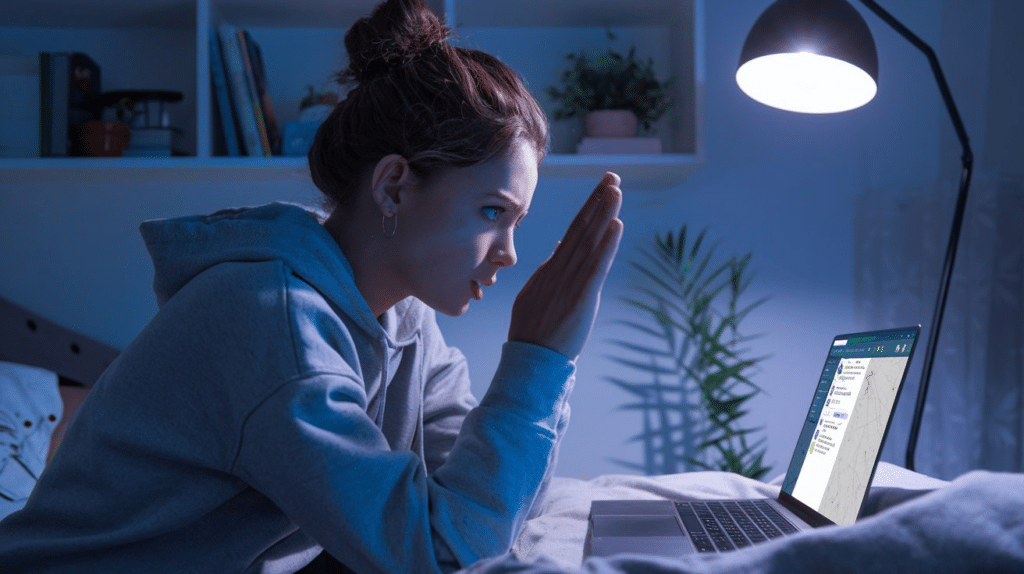Last updated on November 16th, 2024 at 05:49 am
- 1. Understanding Snapchat Addiction
- 1.1 The Allure of Snapchat
- 1.2 Psychological Mechanisms
- 2. Signs and Symptoms of Snapchat Addiction
- 2.1 Behavioral Indicators
- 2.2 Emotional and Psychological Signs
- 3. The Impact of Snapchat Addiction
- 3.1 Mental Health Effects
- 3.2 Social and Relationship Consequences
- 3.3 Academic and Professional Repercussions
- 4. Risk Factors for Snapchat Addiction
- 4.1 Demographic Factors
- 4.2 Psychological Factors
- 4.3 Environmental Factors
- 5. Prevention and Intervention Strategies
- 5.1 Individual Strategies
- 5.2 Family and Community Involvement
- 5.3 Technological Solutions
- 6. Treatment Approaches for Snapchat Addiction
- 6.1 Psychotherapy
- 6.2 Support Groups
- 6.3 Medication
- 7. The Role of Technology Companies
- 7.1 Ethical Design Practices
- 7.2 Research and Collaboration
- 8. Future Directions and Challenges
- 8.1 Emerging Technologies
- 8.2 Policy and Regulation
- 8.3 Ongoing Research Needs
- Snapchat Addiction: The Growing Problem
- Psychological Effects of Excessive Snapchat Use
- Signs of Snapchat Addiction
- The Impact on Mental Health and Social Well-being
- Strategies for Managing Snapchat Addiction
- The Role of Technology in Addiction Prevention
- Social Media Addiction Treatment and Counseling
- Prevention and Long-term Solutions
- Signs of Withdrawal from Snapchat Addiction
- Excessive Time Spent on Snapchat
- The Impact on Academic Performance
- Coping with Snapchat Addiction: Behavioral Approaches
- Social Media Addiction and Its Effects on Physical Health
- Developing Healthy Social Media Habits
- Mental Health Treatment for Snapchat Addiction
- Preventing Snapchat Addiction Relapse
- Psychological Benefits of Limiting Screen Time
- Recognizing Social Media Addiction Signs
- Snapchat Addiction Symptoms and Their Impact on Emotional Health
- Snapchat Addiction and Physical Health
- Strategies to Overcome Snapchat Addiction
- Social Media Addiction Recovery Steps
- Preventing Relapse in Social Media Addiction
- The Role of Social Media Apps in Addiction
- Managing Social Media Impulses
- Behavioral Signs of Social Media Addiction
- Conclusion
- Frequently Asked Questions
- How Can Snapchat Addiction Affect Mental Health?
- What Are the Warning Signs of Snapchat Addiction?
- How Does Snapchat Addiction Impact Academic Performance?
- What Are the Common Symptoms of Snapchat Addiction?
- How Can I Recognize Snapchat Addiction in Teens?
- What Are the Physical Health Effects of Snapchat Addiction?
- What Are Effective Strategies to Quit Snapchat Addiction?
- How Can Snapchat Addiction Be Treated?
- What Is the Psychological Impact of Snapchat Addiction?
- What Are the Most Common Behavioral Signs of Snapchat Addiction?
- How Can Snapchat Addiction Affect Emotional Health?
- How Do Social Media Apps Like Snapchat Trigger Addictive Behaviors?
- Can Snapchat Addiction Lead to Gambling Addiction?
- How Does Snapchat Addiction Relate to Internet Addiction?
- What Is the Role of Dopamine in Snapchat Addiction?
- How Can Time Limits Help Manage Snapchat Addiction?
- What Are the Risks of Excessive Snapchat Use in Adolescents?
- How Can Social Media Addiction Symptoms Be Alleviated?
- What Are the Emotional Effects of Snapchat Addiction?
- How Can Professional Counseling Help with Snapchat Addiction?
In recent years, the popularity of social media platforms has skyrocketed, with Snapchat emerging as a frontrunner among younger demographics. While these platforms offer numerous benefits, including enhanced connectivity and creative expression, they also present potential risks, particularly when usage becomes excessive or compulsive.
This phenomenon, known as Snapchat addiction, has garnered increasing attention from mental health professionals, researchers, and concerned parents alike.
1. Understanding Snapchat Addiction
Snapchat addiction refers to the compulsive and excessive use of the Snapchat application, characterized by an inability to regulate usage despite experiencing negative consequences. This form of behavioral addiction shares similarities with other types of technology-related dependencies, such as internet addiction or smartphone addiction.
1.1 The Allure of Snapchat
Snapchat’s unique features contribute to its addictive potential:
- Ephemeral content: The temporary nature of Snaps creates a sense of urgency and fear of missing out (FOMO).
- Streaks: The gamification of maintaining daily communication with friends can lead to compulsive checking and sending.
- Filters and lenses: These augmented reality features provide instant gratification and encourage frequent use.
- Stories: The ability to share and view 24-hour content feeds into the desire for constant updates and validation.
1.2 Psychological Mechanisms
Several psychological factors contribute to the development and maintenance of Snapchat addiction:
- Dopamine release: The app’s features trigger the brain’s reward system, creating a pleasurable sensation that users seek to repeat.
- Social validation: Likes, views, and responses provide external validation, boosting self-esteem temporarily.
- Escapism: Snapchat can serve as a distraction from real-world problems or negative emotions.
- Fear of missing out (FOMO): The constant stream of updates creates anxiety about being left out of social interactions or events.
2. Signs and Symptoms of Snapchat Addiction
Recognizing the signs of Snapchat addiction is crucial for early intervention and treatment. While occasional heavy use does not necessarily indicate addiction, the following symptoms may suggest a problematic relationship with the app:
2.1 Behavioral Indicators
- Preoccupation: Constantly thinking about Snapchat or planning the next opportunity to use it.
- Loss of control: Inability to cut back on usage despite attempts to do so.
- Neglect of responsibilities: Declining performance at work, school, or in personal relationships due to Snapchat use.
- Continued use despite negative consequences: Persisting with excessive use even when aware of its harmful effects.
- Lying or hiding use: Deceiving others about the amount of time spent on Snapchat.
2.2 Emotional and Psychological Signs
- Mood swings: Experiencing irritability, anxiety, or depression when unable to access Snapchat.
- Withdrawal symptoms: Feeling restless, agitated, or uncomfortable when not using the app.
- Tolerance: Needing to spend increasing amounts of time on Snapchat to achieve the same level of satisfaction.
- Loss of interest: Decreased engagement in previously enjoyed activities or hobbies.
- Cognitive preoccupation: Difficulty concentrating on tasks unrelated to Snapchat.


3. The Impact of Snapchat Addiction
The consequences of Snapchat addiction can be far-reaching, affecting various aspects of an individual’s life:
3.1 Mental Health Effects
- Increased anxiety and depression: Constant comparison to others and fear of missing out can exacerbate existing mental health issues.
- Low self-esteem: Exposure to curated, idealized versions of others’ lives can lead to feelings of inadequacy.
- Body dysmorphia: Excessive use of filters and lenses may distort self-perception and body image.
- Sleep disturbances: Late-night use can interfere with sleep patterns and quality.
3.2 Social and Relationship Consequences
- Impaired social skills: Overreliance on digital communication may hinder the development of in-person social abilities.
- Relationship strain: Excessive Snapchat use can lead to neglect of real-world relationships and intimacy issues.
- Social isolation: Paradoxically, intense focus on virtual connections may result in physical isolation from peers and family.
3.3 Academic and Professional Repercussions
- Decreased productivity: Constant checking and posting can interfere with work or study efficiency.
- Poor time management: Difficulty balancing Snapchat use with other responsibilities.
- Reduced career opportunities: Inappropriate content shared on the platform may have long-term professional consequences.
4. Risk Factors for Snapchat Addiction
Certain factors may increase an individual’s susceptibility to developing a Snapchat addiction:
4.1 Demographic Factors
- Age: Adolescents and young adults are at higher risk due to their developmental stage and peer influence.
- Gender: Some studies suggest females may be more prone to social media addiction, though results are mixed.
- Cultural background: Societal norms and expectations regarding technology use can influence addiction risk.
4.2 Psychological Factors
- Pre-existing mental health conditions: Individuals with anxiety, depression, or attention deficit disorders may be more vulnerable.
- Low self-esteem: Those seeking validation through social media may be at increased risk.
- Impulsivity: Difficulty regulating behavior can contribute to excessive app use.
- Social anxiety: Snapchat may serve as a less threatening alternative to face-to-face interactions for socially anxious individuals.
4.3 Environmental Factors
- Peer pressure: Social norms within friend groups can encourage excessive Snapchat use.
- Lack of parental oversight: Insufficient monitoring of device use may enable problematic behavior.
- Accessibility: Easy access to smartphones and high-speed internet can facilitate addiction.
5. Prevention and Intervention Strategies
Addressing Snapchat addiction requires a multifaceted approach, combining individual strategies, family involvement, and broader societal efforts:
5.1 Individual Strategies
- Self-awareness: Recognizing and monitoring personal Snapchat usage patterns.
- Digital detox: Implementing regular periods of abstinence from the app.
- Time management techniques: Using app timers or scheduling specific times for Snapchat use.
- Alternative activities: Engaging in hobbies, exercise, or in-person social interactions as healthier alternatives.
- Mindfulness practices: Developing present-moment awareness to reduce compulsive app checking.


5.2 Family and Community Involvement
- Open communication: Encouraging dialogue about healthy technology use within families and peer groups.
- Parental guidance: Setting clear rules and boundaries around smartphone and social media use.
- Digital literacy education: Teaching critical thinking skills to evaluate online content and recognize manipulation tactics.
- Support groups: Forming or joining communities focused on maintaining balanced technology use.
5.3 Technological Solutions
- App features: Utilizing built-in tools like Snapchat’s “Do Not Disturb” mode or screen time tracking.
- Third-party apps: Employing applications designed to limit social media use or block certain features.
- Device settings: Customizing smartphone settings to reduce notifications and limit access to addictive apps.
6. Treatment Approaches for Snapchat Addiction
When prevention efforts are insufficient, professional treatment may be necessary to address Snapchat addiction:
6.1 Psychotherapy
- Cognitive-behavioral therapy (CBT): Addressing underlying thought patterns and behaviors contributing to addiction.
- Motivational interviewing: Enhancing motivation for change and exploring ambivalence about app use.
- Acceptance and commitment therapy (ACT): Developing psychological flexibility and aligning behaviors with personal values.
- Family therapy: Involving family members in the treatment process to address systemic issues.
6.2 Support Groups
- Peer support: Connecting with others experiencing similar challenges through in-person or online groups.
- 12-step programs: Adapting traditional addiction recovery models to address technology-related dependencies.
6.3 Medication
While no specific medications are approved for treating Snapchat addiction, addressing co-occurring mental health conditions may be beneficial:
- Antidepressants: May help manage underlying depression or anxiety contributing to excessive app use.
- Anti-anxiety medications: Could alleviate symptoms driving compulsive checking behaviors.
- ADHD medications: Might improve impulse control and attention regulation in individuals with comorbid attention deficit disorders.
7. The Role of Technology Companies
As awareness of social media addiction grows, technology companies face increased pressure to address the addictive potential of their platforms:
7.1 Ethical Design Practices
- Transparency: Providing clear information about data usage and algorithmic content selection.
- User control: Offering more options for customizing app experiences and limiting potentially addictive features.
- Time management tools: Integrating robust usage tracking and limitation features directly into the app.


7.2 Research and Collaboration
- Funding studies: Supporting independent research on the effects of social media use on mental health and well-being.
- Partnering with experts: Collaborating with mental health professionals to develop healthier platform designs.
- Data sharing: Providing anonymized user data to researchers to better understand usage patterns and potential interventions.
8. Future Directions and Challenges
As technology continues to evolve, addressing Snapchat addiction will require ongoing adaptation and innovation:
8.1 Emerging Technologies
- Virtual and augmented reality: Considering the potential addictive properties of increasingly immersive social media experiences.
- Artificial intelligence: Exploring the use of AI to detect and intervene in problematic usage patterns.
- Wearable devices: Integrating addiction prevention strategies into smartwatches and other wearable technology.
8.2 Policy and Regulation
- Age restrictions: Debating appropriate age limits for social media access and enforcement mechanisms.
- Educational initiatives: Implementing digital citizenship curricula in schools to promote healthy technology use.
- Industry standards: Developing guidelines for ethical design practices in social media applications.
8.3 Ongoing Research Needs
- Long-term effects: Conducting longitudinal studies to understand the lasting impact of social media addiction on development and well-being.
- Neurobiological mechanisms: Further investigating the brain changes associated with compulsive social media use.
- Cultural variations: Examining how Snapchat addiction manifests across different cultural contexts and demographics.
Snapchat Addiction: The Growing Problem
The increasing dependence on social media platforms, particularly the Snapchat app, has led to a surge in concerns about Snapchat addiction. The constant stream of personalized content, instant gratification, and social validation makes it difficult for many individuals to recognize the onset of compulsive behavior. As Snapchat’s popularity continues to rise, so does the need for awareness about how to manage excessive usage effectively.
Psychological Effects of Excessive Snapchat Use
The release of dopamine triggered by the Snapchat app’s features can create a surge of pleasure that users seek to replicate, leading to addictive behaviors. This neurotransmitter plays a significant role in maintaining the habit, creating a feedback loop where excessive time spent on the app becomes harder to control. Social media addiction symptoms are closely linked to similar issues found in gambling addiction, as both involve compulsive behaviors aimed at achieving short-term gratification.
Excessive screen time can disrupt an individual’s daily routine and increase feelings of loneliness and isolation. These feelings may drive users to spend even more time on the app, contributing to the development of addiction. As users experience a surge in dopamine from the app’s interactive features, the addiction strengthens, reinforcing the pattern of use.
Signs of Snapchat Addiction
Recognizing Snapchat addiction is critical for intervention. Common signs of Snapchat overuse include neglecting responsibilities and experiencing withdrawal symptoms when the app is unavailable. Snapchat addiction symptoms are often marked by compulsive behaviors, such as checking the app frequently, even when it’s not necessary. These behaviors can be indicative of a broader social media addiction, with users unable to stop using the app despite negative consequences in their personal and academic life.
Common signs of addiction among children and teens can include declining academic performance, emotional health issues, and a lack of engagement in physical activities. The constant interaction with the app can interfere with real-world interaction and lead to a significant reduction in time spent with friends and family. The overuse of social media apps like Snapchat has been shown to negatively affect both physical and mental health, contributing to mood disorders, anxiety, and depression.


The Impact on Mental Health and Social Well-being
Snapchat addiction can significantly affect emotional health, leading to heightened levels of anxiety and depressive symptoms. Social media habits that revolve around seeking validation through likes, comments, and views can exacerbate feelings of inadequacy, particularly when users compare themselves to others. This can contribute to a decline in self-esteem and increase susceptibility to mood disorders.
The addictive nature of Snapchat can also hinder the development of real-life connections. Although the app provides a form of social connection, it can never replace the emotional bond built through real-world interaction. The reliance on digital communication may prevent individuals from experiencing the psychological benefits of face-to-face relationships, contributing to feelings of loneliness and isolation.
Strategies for Managing Snapchat Addiction
Effectively managing Snapchat usage requires a multi-faceted approach. One common strategy is setting time limits on the app, which can help reduce excessive screen time and prevent compulsive checking. A social media detox, such as a 5-day social media detox, can help break the cycle of addiction and encourage individuals to rediscover once-enjoyed activities. Limiting Snapchat consumption through the use of built-in app timers and device settings can also be beneficial.
Snapchat addiction recovery steps often involve recognizing signs of Snapchat overuse early and taking immediate action. For those struggling to reduce their screen time, seeking professional assistance through social media addiction counseling can be a critical step. Additionally, implementing alternative activities like engaging in physical activities or spending quality time with friends can offer an emotional connection that reduces dependency on social media apps.
The Role of Technology in Addiction Prevention
The very tools that make Snapchat addictive can also be leveraged to help manage and overcome Snapchat addiction. Many smartphones now include features that help users monitor their usage, such as screen time tracking and notifications for excessive app use. By using these tools, individuals can limit Snapchat consumption and track their progress over time.
Technological advancements in addiction treatment have also led to the development of online treatment locators, which can connect users with resources for managing their addiction. Social media addiction therapy, when combined with traditional therapeutic methods like Cognitive Behavioral Therapy (CBT), can be highly effective in helping individuals regain control over their digital habits.
Social Media Addiction Treatment and Counseling
As awareness of social media addiction grows, the need for comprehensive treatment options has become more evident. Social media addiction treatment programs offer specialized counseling for those experiencing compulsive social media behavior. These programs provide the structure and support necessary for individuals to break free from harmful online habits and reintegrate into everyday life without excessive reliance on social media apps.
Treatment strategies may involve addressing the root causes of addiction, such as underlying mood disorders or feelings of loneliness. Mental health and social media addiction are closely linked, and treating one can have a profound impact on the other. By addressing both the psychological and emotional aspects of addiction, individuals can experience improved well-being and a healthier relationship with technology.
Prevention and Long-term Solutions
Preventing Snapchat addiction requires an ongoing effort to maintain balanced online habits. Social media detox strategies, such as scheduled breaks or regular offline periods, can help maintain a healthy relationship with social media apps. Recognizing social media addiction signs early and developing a plan to manage usage can prevent the escalation of compulsive behavior.
Strategies to quit Snapchat involve setting personal boundaries, reducing screen time, and focusing on real-world connections. Support groups, whether online or in-person, can provide valuable resources and emotional support for those working to overcome addiction. These support systems can also help prevent a relapse into excessive use, offering ongoing motivation and encouragement for those in recovery.
Signs of Withdrawal from Snapchat Addiction
As Snapchat addiction deepens, users often experience signs of withdrawal when attempting to reduce their usage. This can manifest as feelings of anxiety or irritability, which may interfere with their daily routine and social interactions. Signs of Snapchat overuse are not always immediately apparent, but when withdrawal symptoms occur, it becomes clear that the addiction is affecting both mental and emotional health.
Psychologically, users may feel a constant need to check their Snapchat account, even in situations where it isn’t appropriate. The inability to control this compulsion can lead to greater social media addiction symptoms, making it difficult for the individual to re-engage in real-life connections.
Excessive Time Spent on Snapchat
Excessive amounts of time spent on Snapchat can alter one’s personal life, especially as the app begins to consume more hours in the day. The addictive nature of the app results in compulsive behavior, where users cannot stop themselves from checking the endless stream of content, leading to a breakdown in real-world interaction. Over time, this behavior can disrupt one’s academic performance and professional productivity.
Furthermore, excessive Snapchat use may overshadow other aspects of daily life, such as physical health and emotional well-being. Compulsive Snapchat behavior can prevent individuals from engaging in necessary physical activities, which are crucial for overall health.


The Impact on Academic Performance
Snapchat addiction can have profound effects on academic grades and performance. Adolescents and young adults may struggle to focus on their studies due to frequent distractions from checking the app. Academic performance often declines when excessive time on social media apps like Snapchat takes precedence over homework or studying for exams.
This addiction in teens can lead to missed deadlines and lower grades, which in turn can affect their future educational and career opportunities. Social media addiction signs often include poor time management and a decrease in the quality of work, especially when students prioritize digital interaction over real-life academic responsibilities.
Coping with Snapchat Addiction: Behavioral Approaches
Behavioral strategies are critical when managing Snapchat addiction, particularly when trying to limit excessive screen time. Recognizing the behavioral signs of Snapchat addiction early on allows users to implement healthier coping mechanisms. Setting time limits on Snapchat can be an effective strategy to regain control and prevent impulsive checking.
For those dealing with excessive Snapchat use, strategies to quit Snapchat should include building awareness of the amount of time spent on the app. Developing new routines that promote offline social connections and physical activities can help replace the emotional satisfaction that users seek through Snapchat’s personalized content.
Social Media Addiction and Its Effects on Physical Health
The psychological impact of Snapchat addiction can extend to physical health, as users often experience disrupted sleep patterns due to late-night screen time. Excessive screen time before bed has been linked to poor sleep hygiene, which can worsen mood disorders and lead to long-term health consequences. Recognizing the physical signs of social media addiction, like eye strain or fatigue, is key to addressing the issue.
In addition, the surge of dopamine caused by compulsive app use can lead to decreased motivation to participate in physical activities. This lack of exercise can increase the risk of chronic conditions like obesity or cardiovascular diseases, emphasizing the importance of balancing screen time with physical health.


Developing Healthy Social Media Habits
To break free from Snapchat addiction, users must cultivate healthy social media habits. Limiting screen time, setting boundaries around when and how often to use the app, and taking regular breaks can prevent the compulsive behaviors associated with Snapchat addiction. Time limits can also be customized on devices to reduce the temptation to spend excessive hours on the app.
The development of alternative activities, such as spending time with friends or engaging in hobbies, can help individuals avoid the trap of addictive behaviors. Focusing on real-life relationships can also improve emotional well-being, providing a greater sense of connection that is often missing from digital interactions.
Mental Health Treatment for Snapchat Addiction
For those experiencing significant emotional distress due to Snapchat addiction, mental health treatment is a critical step. Social media addiction treatment centers provide specialized care to help individuals cope with the psychological effects of excessive screen time. Professional counseling and therapy programs can address underlying mood disorders, such as anxiety or depression, which may be exacerbated by the constant use of social media apps.
In addition to therapy, individualized treatment programs can help individuals identify the root causes of their addiction and develop long-term strategies to manage their usage. Using an online treatment locator can assist in finding appropriate services tailored to address Snapchat addiction symptoms, providing a crucial resource for those in need of help.
Preventing Snapchat Addiction Relapse
Preventing Snapchat addiction relapse requires a proactive approach that involves ongoing support and consistent self-regulation. Regular check-ins with a therapist or counselor can help individuals track their progress and reinforce healthier social media habits. Additionally, participating in social media addiction recovery steps can provide motivation and accountability to ensure long-term success.
One effective relapse prevention strategy is engaging in a social media detox, which can be part of an overall digital detox strategy. This allows individuals to reconnect with real people and practice social skills that are often neglected in the virtual world. By setting clear goals and regularly evaluating one’s relationship with technology, users can protect themselves from falling back into compulsive behavior.
Psychological Benefits of Limiting Screen Time
Reducing excessive Snapchat usage can have numerous psychological benefits. Limiting screen time allows for the development of real-life connections, fostering deeper emotional connections with family and friends. These relationships contribute to improved emotional health, reducing feelings of loneliness that often accompany social media addiction.
The psychological impact of reducing screen time is also seen in improved focus and concentration. As users spend less time immersed in digital content, they can devote more attention to activities that promote personal growth, such as pursuing hobbies or engaging in physical activities. The shift towards healthier social media habits helps in restoring balance to one’s daily life.
Recognizing Social Media Addiction Signs
One of the first steps in managing Snapchat addiction is recognizing the signs of addiction early on. Social media addiction signs are often subtle but become more apparent as the behavior escalates. Common symptoms of social media addiction include excessive use, neglect of responsibilities, and emotional distress when unable to check the app.
As social media apps like Snapchat become an integral part of daily life, addiction behaviors can creep in unnoticed. Users may feel compelled to interact with personalized content regularly, which can turn into compulsive usage over time. Identifying these behavioral signs is crucial for timely intervention to prevent long-term negative effects.
Snapchat Addiction Symptoms and Their Impact on Emotional Health
The emotional health of an individual can be greatly affected by Snapchat addiction. Social media addiction symptoms, including mood swings and anxiety, often occur when users feel disconnected from the stream of content or fear missing out. The constant desire to stay updated leads to a constant feeling of urgency, impacting one’s overall mood and emotional well-being.
Negative feelings are common among individuals who overuse Snapchat, as their emotional connection to online interactions replaces real-life connections. This imbalance can lead to a deterioration in personal relationships and contribute to feelings of loneliness. Addressing the psychological effects of excessive Snapchat use is key to restoring emotional health.
Snapchat Addiction and Physical Health
Excessive time spent on Snapchat can have negative consequences on physical health. The surge of dopamine during app use may contribute to addictive behaviors, but it also leads to unhealthy patterns of screen time, which can affect sleep quality. This is particularly evident in individuals who use Snapchat late into the night, disrupting their circadian rhythms.
Additionally, long periods of sitting while using Snapchat can result in a sedentary lifestyle, which is linked to poor physical health outcomes, such as weight gain or cardiovascular problems. Incorporating physical activities into daily routines can counteract these negative effects and improve overall well-being, helping users regain control over their health.
Strategies to Overcome Snapchat Addiction
Overcoming Snapchat addiction involves a combination of self-discipline and professional intervention. Time management techniques, such as setting specific time limits, can help users reduce excessive screen time. By establishing boundaries around when to use Snapchat, individuals can better manage their usage and mitigate the impact on their daily life.
Digital detox strategies, such as a 5-day social media detox, provide a structured way for users to disconnect from Snapchat and regain a sense of balance. This break allows individuals to recalibrate and reflect on their relationship with technology, fostering healthier habits moving forward.


Social Media Addiction Recovery Steps
Recovering from social media addiction, including Snapchat dependency, often requires structured support. Social media addiction recovery steps involve identifying the root causes of compulsive use and developing coping mechanisms for stress or anxiety that don’t rely on technology. One effective recovery method is social media addiction therapy, which provides tools to address underlying issues and prevent relapse.
Therapeutic interventions can include mindfulness techniques, which help individuals become more aware of their social media habits and manage the psychological triggers that lead to overuse. Support groups for those struggling with compulsive social media behavior offer a sense of community and accountability, making it easier to maintain progress.
Preventing Relapse in Social Media Addiction
Preventing relapse in social media addiction requires consistent effort and self-regulation. Even after overcoming Snapchat addiction, it is important to stay mindful of potential triggers that could lead to a return to excessive use. Time limits and the use of apps to block or restrict usage can help individuals maintain healthy digital habits.
A social media addiction relapse can be avoided through ongoing social media habits adjustments and by keeping a balanced focus on real-life connections. By consciously reducing screen time and nurturing offline relationships, individuals can safeguard against slipping back into unhealthy usage patterns.
The Role of Social Media Apps in Addiction
While social media apps like Snapchat are designed to engage users, their features can unintentionally promote addictive behaviors. The endless stream of personalized content, along with real-time notifications, creates a perfect environment for compulsive checking. This design, which rewards instant gratification, is a key contributor to the development of addiction.
Understanding the psychological effects of these design features can help users take control of their Snapchat usage. By recognizing the manipulative elements of these apps, such as the release of dopamine from likes and streaks, individuals can be more intentional in managing their social media consumption.
Managing Social Media Impulses
Managing social media impulses is a vital part of overcoming Snapchat addiction. Acknowledging that excessive usage may be a response to difficult feelings like anxiety or loneliness can help individuals better control their impulses. Strategies for controlling Snapchat impulses include using mindfulness techniques, journaling, or engaging in physical activities to distract from the urge to check the app.
By consciously practicing self-restraint and limiting exposure to social media apps, users can avoid triggering the compulsive behaviors that lead to addiction. Understanding the link between social media interaction and dopamine production allows individuals to reduce their reliance on Snapchat for emotional validation.
Behavioral Signs of Social Media Addiction
The behavioral signs of social media addiction can be easy to overlook at first, but they become more noticeable as the addiction deepens. These signs include preoccupation with Snapchat, the constant need to check for updates, and a lack of control over app usage. Other common signs of Snapchat overuse include lying about how much time is spent on the app or neglecting other activities in favor of Snapchat use.
Behavioral signs may also include a decline in academic grades, as users focus more on maintaining Snapchat streaks than on their studies. Recognizing these behavioral signs early can help individuals take steps to break the cycle of addiction before it negatively impacts their daily life.
Conclusion
Snapchat addiction represents a complex challenge at the intersection of technology, psychology, and society. By fostering awareness, promoting responsible use, and developing effective interventions, we can work towards a future where the benefits of social media are maximized while minimizing its potential for harm.
As our understanding of this phenomenon continues to evolve, so too must our strategies for prevention, treatment, and ethical platform design.
Frequently Asked Questions
How Can Snapchat Addiction Affect Mental Health?
Snapchat addiction can significantly impact mental health, leading to increased anxiety and depression. Spending too much time on the app can result in emotional instability, as users may become dependent on online validation.
Excessive use of social media apps like Snapchat may cause users to struggle with real-world interactions. Over time, this dependence on virtual communication can make it harder for individuals to manage their emotions and mental health effectively. Source: Mayo Clinic


What Are the Warning Signs of Snapchat Addiction?
Signs of Snapchat addiction include compulsively checking the app, even during inappropriate times. Users may also become anxious or upset when unable to use the app, leading to irritability or mood swings.
Another warning sign is neglecting responsibilities or social obligations in favor of time spent on the app. When Snapchat starts to interfere with daily life and routines, it may be an indicator of a growing addiction. Source: WebMD
How Does Snapchat Addiction Impact Academic Performance?
Snapchat addiction often leads to distractions that negatively affect academic performance. Students who spend excessive time on the app may find it difficult to focus on their studies, resulting in lower academic grades.
In addition to poor focus, excessive screen time can disrupt sleep patterns. Lack of sleep can further reduce cognitive function, making it harder for students to retain information and perform well academically. Source: Psychology Today
What Are the Common Symptoms of Snapchat Addiction?
Common symptoms of Snapchat addiction include compulsively checking for new notifications and the need to share content frequently. Users may also feel anxious or restless if they are unable to engage with the app.
This constant desire to stay connected can lead to neglecting other important aspects of life. As addiction grows, users may find themselves prioritizing Snapchat over work, relationships, or personal well-being. Source: National Institute on Drug Abuse
How Can I Recognize Snapchat Addiction in Teens?
Teens addicted to Snapchat often exhibit signs such as withdrawal when they cannot access the app. They may become irritable or anxious, making it difficult to manage everyday tasks or social interactions.
Additionally, teens may prioritize Snapchat over in-person relationships, leading to a reduction in real-world social connections. As the addiction deepens, they may spend more time on the app and less time engaging in face-to-face interactions. Source: Child Mind Institute
What Are the Physical Health Effects of Snapchat Addiction?
One of the physical health effects of Snapchat addiction is eye strain caused by prolonged screen time. Excessive use of social media apps can lead to headaches, tiredness, and discomfort in the eyes.
In addition to eye strain, Snapchat addiction can disrupt sleep patterns. The blue light from screens interferes with the production of melatonin, making it harder for users to fall asleep and affecting their overall physical health. Source: Sleep Foundation
What Are Effective Strategies to Quit Snapchat Addiction?
To quit Snapchat addiction, setting strict time limits for app usage is an essential strategy. This helps users to reduce screen time and make time for healthier activities like physical exercise or socializing with friends in real life.
Another effective strategy is to gradually replace Snapchat with more fulfilling offline activities. For example, engaging in hobbies, spending time outdoors, or focusing on work can help reduce dependency on the app. Source: American Psychological Association
How Can Snapchat Addiction Be Treated?
Snapchat addiction treatment often involves therapy, including cognitive-behavioral therapy (CBT). CBT helps individuals identify and modify unhealthy behaviors related to excessive Snapchat use.
In addition to therapy, behavioral interventions such as digital detox or establishing healthy habits are also key to recovery. Individualized treatment programs can provide tailored solutions to manage addiction effectively. Source: National Institute of Mental Health
What Is the Psychological Impact of Snapchat Addiction?
The psychological impact of Snapchat addiction can manifest in mood disorders such as anxiety or depression. Constant engagement with personalized content can lead to unhealthy comparisons and self-esteem issues.
Over time, users may become more reliant on virtual interactions rather than real-world relationships. This shift can contribute to feelings of isolation, loneliness, and emotional distress. Source: WebMD
What Are the Most Common Behavioral Signs of Snapchat Addiction?
Common behavioral signs of Snapchat addiction include checking the app compulsively, even at inappropriate times. Users may also feel a constant urge to refresh notifications, even during activities that require attention.
Additionally, addicted individuals may begin to neglect responsibilities or become disengaged in social settings. This behavior can indicate a growing dependency on the app and a disruption of normal daily routines. Source: Mayo Clinic
How Can Snapchat Addiction Affect Emotional Health?
Snapchat addiction can negatively affect emotional health by causing users to rely on social media for validation. This constant need for external affirmation can lead to heightened anxiety and depression.
Furthermore, addiction to the app may interfere with real-life connections, leading to increased feelings of loneliness. The emotional toll of Snapchat addiction can escalate if unhealthy online interactions replace in-person communication. Source: American Psychological Association


How Do Social Media Apps Like Snapchat Trigger Addictive Behaviors?
Snapchat, like many other social media apps, triggers addictive behaviors by delivering a constant stream of content. This endless cycle of personalized content and notifications creates a dopamine-driven reward system that reinforces the need to check the app frequently.
The surge of dopamine produced by these interactions can make users feel good, encouraging them to keep returning to the app. Over time, this can result in habitual behaviors that are hard to break without intervention. Source: National Institute on Drug Abuse
Can Snapchat Addiction Lead to Gambling Addiction?
Snapchat addiction can potentially lead to gambling addiction due to the similar compulsive behaviors involved. Both addictions stem from the desire for immediate gratification and the release of dopamine, which can escalate over time.
When individuals experience a constant need for stimulation, they may seek other activities, like gambling, that also offer instant rewards. This overlap in addictive behaviors underscores the need to address compulsive habits early to prevent further issues. Source: American Psychiatric Association
How Does Snapchat Addiction Relate to Internet Addiction?
Snapchat addiction is a form of internet addiction, where excessive use of social media apps takes priority over real-life activities. Like other forms of internet addiction, Snapchat dependency can interfere with daily responsibilities, such as work, school, and personal relationships.
The constant use of social media apps contributes to unhealthy online habits, which may lead to emotional and physical health problems. Addressing the root cause of internet addiction can help individuals break free from compulsive behaviors related to Snapchat and other platforms. Source: WebMD
What Is the Role of Dopamine in Snapchat Addiction?
Dopamine plays a central role in Snapchat addiction, as it is the neurotransmitter associated with pleasure and reward. Each time users check the app and receive new snaps or notifications, the brain releases dopamine, creating feelings of happiness and satisfaction.
This release of dopamine reinforces the behavior of checking Snapchat frequently, leading to habitual use. Over time, the brain becomes conditioned to expect these rewards, making it difficult for individuals to reduce their screen time. Source: National Institute on Drug Abuse
How Can Time Limits Help Manage Snapchat Addiction?
Setting time limits on Snapchat usage is a practical way to help manage addiction. By limiting daily screen time, users can reduce the temptation to check the app frequently and focus on other activities.
Time limits encourage individuals to engage in healthier habits, such as spending time with friends or participating in physical activities. Over time, these small changes can help break the cycle of excessive Snapchat use. Source: Psychology Today
What Are the Risks of Excessive Snapchat Use in Adolescents?
Excessive Snapchat use in adolescents can lead to various negative outcomes, including poor academic performance and emotional issues. Teens may become more focused on online interactions than their real-world responsibilities, which can hurt their mental and physical health.
The addictive behaviors associated with Snapchat can also increase the risk of cyberbullying and social anxiety. Addressing these issues early on is crucial to prevent further emotional distress and maintain a healthy balance between online and offline activities. Source: Child Mind Institute
How Can Social Media Addiction Symptoms Be Alleviated?
Social media addiction symptoms can be alleviated through strategies such as a digital detox. Taking a break from platforms like Snapchat allows users to reset their habits and reduce dependence on constant notifications.
Seeking professional help, including counseling or therapy, can also aid in managing addiction. Therapeutic approaches such as cognitive-behavioral therapy (CBT) can help individuals address the underlying psychological effects of their social media usage. Source: American Psychological Association
What Are the Emotional Effects of Snapchat Addiction?
Snapchat addiction can have serious emotional effects, leading to feelings of anxiety and depression. Users may become overly concerned with their online presence, which can harm their self-esteem and emotional stability.
Over time, this emotional dependence on the app can lead to greater isolation and loneliness. Users may also experience increased levels of stress due to the pressure of maintaining an idealized online persona. Source: Mayo Clinic
How Can Professional Counseling Help with Snapchat Addiction?
Professional counseling can play a critical role in treating Snapchat addiction by helping individuals understand the root causes of their compulsive behaviors. Therapy, such as cognitive-behavioral therapy (CBT), assists users in recognizing harmful patterns and finding healthier ways to cope with difficult emotions.
Counsel




